
Edinburgh Research Archive • www.era.lib.ed.ac.uk • ERdata: Jan. – June 2019
The first half of 2019 saw the fifth highest total of downloads from ERA over a six-month period, unfortunately this is the lowest total of its ‘mature’ phase (since Jan-Jun 2017 download numbers have been consistently higher than 300,000 per 6-month block).
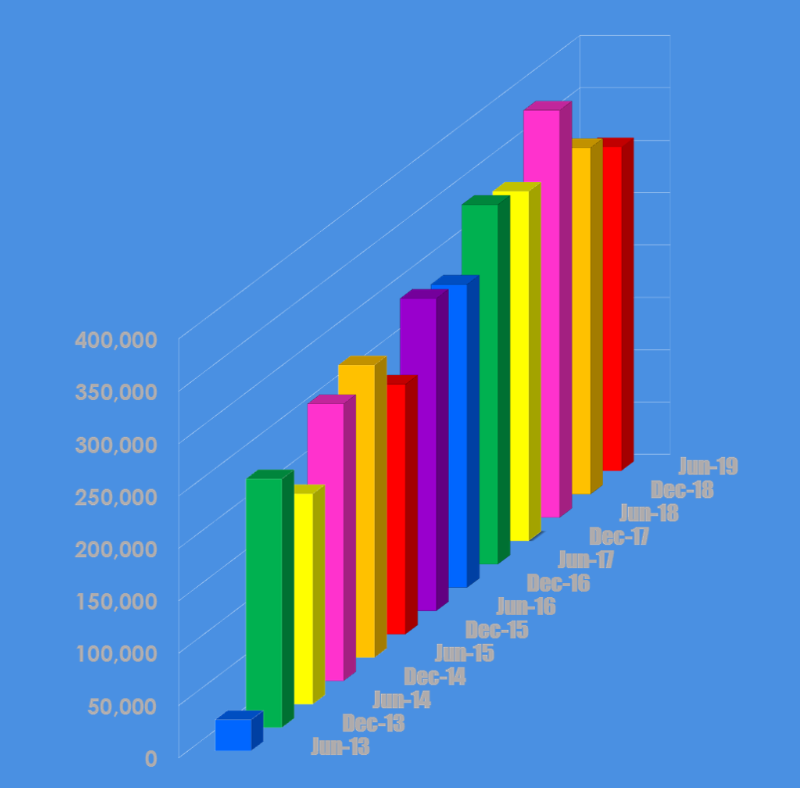
More disappointingly, this is the first time in ERAs history that we’ve witnessed a fall-off in numbers in two consecutive blocks: December 2018 saw a 15% decline and June 2109 has brought a further decline of 6.5%.
The remainder of this report aims to offer an overview of the last six-months of download activity on the Edinburgh Research Archive. Using data generated through the IRUS-UK download statistics portal to investigate that activity under the following headings:
[Also available as a PDF – 605kb]
a. Downloads by Country:
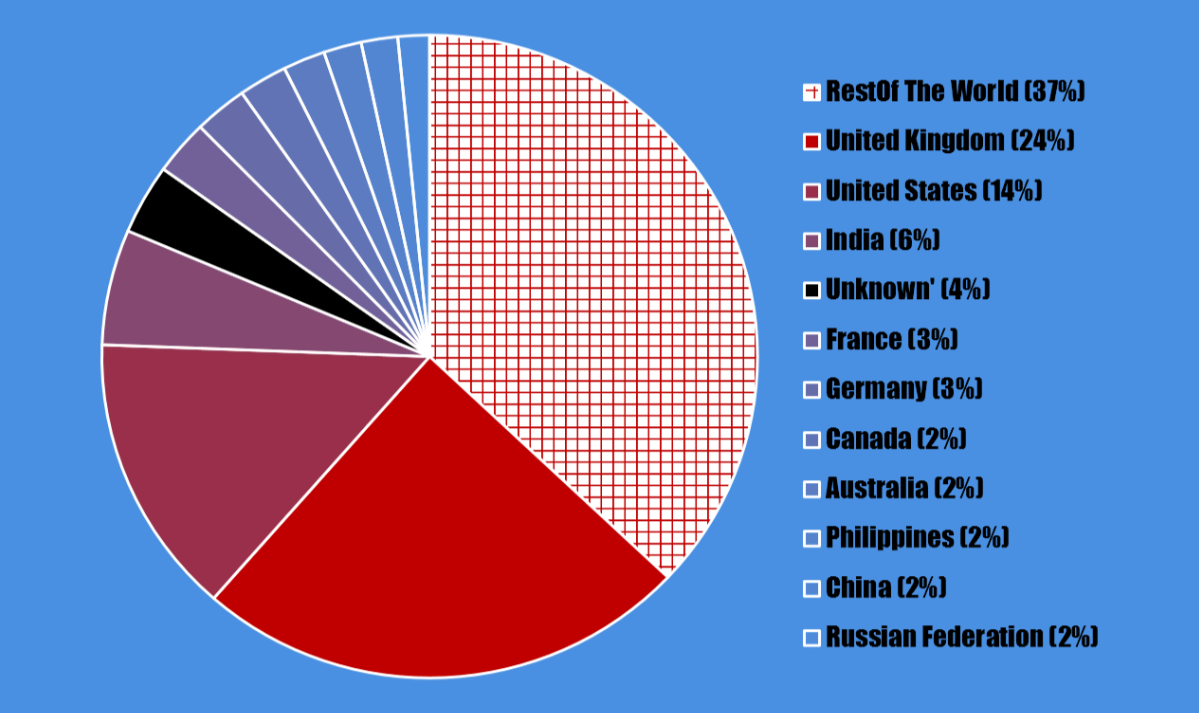
Ostensibly exhibiting the same general patterns as Edinburgh Research Explorer: with the largest audience blocks defined by language groups – UK English, followed by native English speakers. There is a slightly more exotic selection of countries with English-as-additional-language speakers: a few of our neighbouring countries and China have much reduced shares, allowing India, the Philippines and Russia to move higher up the rankings without actually increasing their shares.
With the lower numbers at the top of the list, ERA displays a much stronger tail: the ‘Rest of the World’ as a block accounted for 37% compared to Explorer’s 21% of downloads, and that block was made up of a slightly larger figure of 220 other countries and territories.
b. Downloads by Item-type:
Thesis make up nearly 90% of ERA’s downloads, with the other 10% being very much a mish-mash of this and that, and as might be expected there’s very little overlap with Research Explorer:
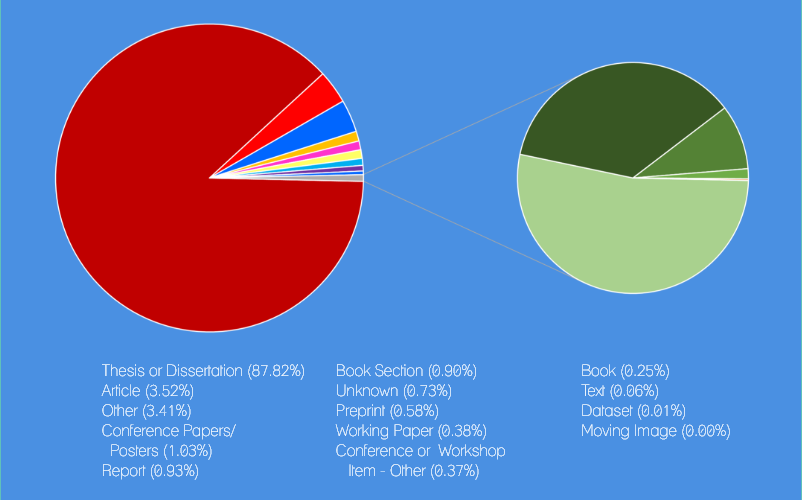
c. Downloads by Title:
Of the 309,074 downloads from ERA over the first six-months of 2019, the most popular title only accounted for 2% of them (6,139). The nine remaining titles in the top 10, accounted for a further 14,440 downloads (4.7%); the top 10 as a whole therefore, accounted for just 6.7%.
The Top 10:
- 10. ‘Angels in Islam: a commentary with selected translations of Jalāl al-Dīn al-Suyūṭī’s Al-Ḥabā’ik fī akhbār almalā’ik (The Arrangement of the Traditions about Angels)‘ by Burge, Stephen Russell.
Item-type: Thesis or Dissertation
Creation Date: 2010
Date Accessioned: 28/10/2010
Downloads: 784 in 2019 / 4,810 in total (16%)
Audience (2019): USA (20%) | UK (17%) | India (5%)
Peak: 152 June 2019
URL: http://hdl.handle.net/1842/4110 - 09. ‘Ethnicity and Power in Ethiopia‘ by Vaughan, Sarah.
Item-type: Thesis or Dissertation
Creation Date: 2003
Date Accessioned: 14/10/2004
Downloads: 787 in 2019 / 13,031 in total (6%)
Audience (2019): Ethiopia (59%) | USA (10%) | UK (5%)
Peak: 441 December 2016
URL: http://hdl.handle.net/1842/605 - 08. ‘Negative space of things: a practice-based research approach to understand the role of objects in the Internet of Things‘ by Shingleton, Duncan James.
Item-type: Thesis or Dissertation
Creation Date: 2018
Date Accessioned: 06/11/2018
Downloads: 819 in 2019 / 1,007 in total (81%)
Audience (2019): USA (18%) | ‘Unknown’ (12%) | UK (11%)
Peak: 198 March 2019
URL: http://hdl.handle.net/1842/33221 - 07. ‘Resourcing the local church: attitudes among Mozambican evangelicals towards economic dependency and self-reliance‘ by Reeve, Richard John.
Item-type: Thesis or Dissertation
Creation Date: 2018
Date Accessioned: 22/06/2018
Downloads: 838 in 2019 / 1,323 in total (63%)
Audience (2019): USA (16%) | Iran (15%) | UK (7%)
Peak: 205 March 2019
URL: http://hdl.handle.net/1842/31474 - 06. ‘Can we put the ‘poverty of aspiration’ myth to bed now?‘ by Treanor, Morag.
Item-type: Other
Creation Date: 2017
Date Accessioned: 20/12/2017
Downloads: 1,002 in 2019 / 2,413 in total (42%)
Audience (2019): UK (42%) | Canada (29%) | USA (25%)
Peak: 462 may 2019
URL: http://hdl.handle.net/1842/25787 - 05. ‘Soviet montage cinema as propaganda and political rhetoric‘ by Russell, Michael.
Item-type: Thesis or Dissertation
Creation Date: 2009
Date Accessioned: 27/10/2010
Downloads: 1,054 in 2019 / 10,021 in total (11%)
Audience (2019): USA (26%) | UK (21%)
Peak: 347 April 2018
URL: http://hdl.handle.net/1842/4084 - 04. ‘Digital disruption in the recording industry‘ by Sun, Hyojung.
Item-type: Thesis or Dissertation
Creation Date: 2017
Date Accessioned: 05/10/2017
Downloads: 1,637 in 2019 / 2,107 in total (78%)
Audience (2019): USA (16%) | UK (10%) | ‘Unknown’ (8%)
Peak: 350 February 2019
URL: http://hdl.handle.net/1842/23631 - 03. ‘Study of popular Hong Kong cinema from 2001 to 2004 as resource for a contextual approach to expressions of christian faith in the public realm after the reversion to Chinese sovereignty in 1997‘ by Yam, Chi-Keung.
Item-type: Thesis or Dissertation
Creation Date: 2008
Date Accessioned: 21/10/2010
Downloads: 3,588 in 2019 / 8,656 in total (41%)
Audience (2019): Iran (20%) | USA (16%) | UK (5%)
Peak: 693 June 2019
URL: http://hdl.handle.net/1842/4015 - 02. ‘The Laird’s Houses of Scotland: From the Reformation to the Industrial Revolution, 1560-1770‘ by Strachan, Sabina Ross.
Item-type: Thesis or Dissertation
Creation Date: 2008
Date Accessioned: 06/07/2010
Downloads: 3,931 in 2019 / 7,063 in total (56%)
Audience (2019): USA (20%) | UK (09%) | ‘Unknown’ (7%) | Romania (7%)
Peak: 1,201 January 2019
URL: http://hdl.handle.net/1842/3485 - 01. ‘Civil Defence Manual of Basic Training volume II Basic Fire Fighting‘ by Civil Defence Dept.
Item-type: Other
Creation Date: 1949
Date Accessioned: 20/09/2011
Downloads: 6,139 in 2019 / 72,115 in total (9%)
Audience (2019): India (33%) | Philippines (8%) | UK (6%)
Peak: 2,272 March 2017
URL: http://hdl.handle.net/1842/5436
Given what we’ve seen with every other measurement, and what we might expect given the nature of the material archived there, it might be presumed that ERA would display a much longer tail than Research Explorer – well, it does and it doesn’t. Although ERA has a much more fragmented audience, it has a significantly smaller volume of active material: the remaining 93.3% of the non-Top 10 downloads were distributed amongst 20,501 titles (only 58% of the equivalent figure on Research Explorer); whilst 5,334 titles were only downloaded once (26%), compared to 22% in Explorer.
The difference in the sizes of the active collections between ERA and Explorer seems emphatic, and raises the question of whether its smaller size is now restraining the amount of downloading activity on ERA? Well, at the last count ERA contained 34,718 files, so coincidentally only 59% of the archive is active. This compares to 35,442 downloaded files from 152,333 research outputs on Research Explorer (just 23% are active).
d. Other factors:
ERA’s ‘mature’ phase is difficult to explain from these figures: was it just coincidence that it commenced around the same time as the launch of Research Explorer and coincided with the first significant numbers of uploads from the Thesis Scanning Project hitting their stride?
ERA’s ‘mature’ phase commenced in the Jan-June 2017 block, Edinburgh Research Explorer was launched in May 2017. The number of downloads became much more stable from that time, and for an 18-month period they looked quite similar. It’s only over the last year, that ERA seems to have not only been left a long way behind, but to have gone backwards.
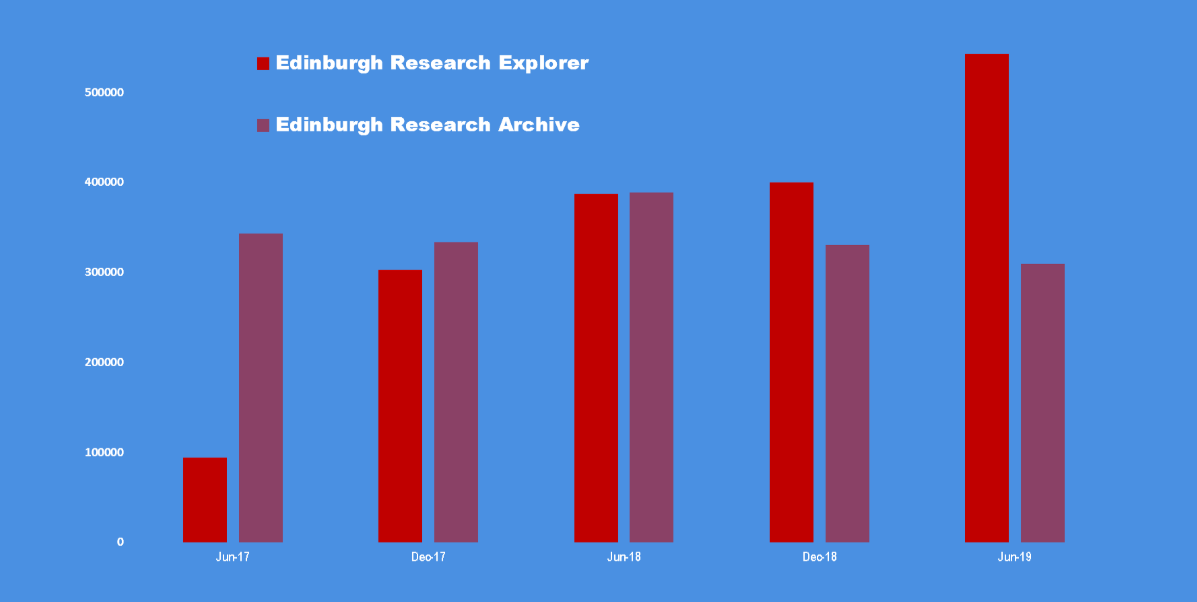

No. of different items downloaded per month;
Cumulative no. of items uploaded from the Thesis Scanning Project; from May 2016 – June 2019
The monthly figures (Fig. v) suggest something more complex: ERA had already been enjoying a growth spurt, which if anything was briefly curtailed by the emergence of Explorer. Certainly it peaked in March 2017, and although the numbers fall-off in the following months, this was in line with ERA’s established (and on-running) pattern of usage falling-off from April to June). That said, the decline in that year was more emphatic than any other.
Similarly, the Thesis Scanning project had started tentatively uploading theses to ERA in July of 2016, reaching 2,307 by December (see Fig. v). By the end of the following six-months this had more than doubled to 4,753. It’s difficult to connect the two factors, because as has already been mentioned, ERA’s figures were in the midst of their annual summer slump when the first theses were uploaded, and so it was expected that they would rise in the subsequent months. Likewise, a pattern of significantly increased activity compared to the previous year had also already been emphatically established (see Fig. vi below)
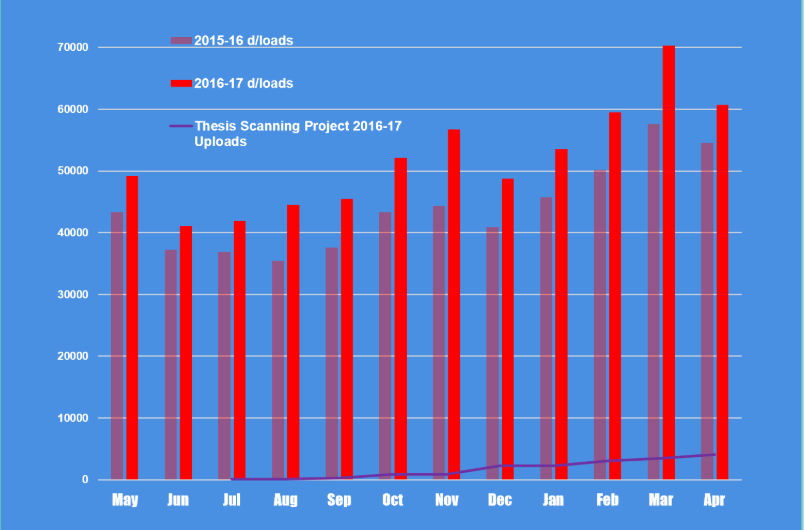
Thesis Scanning Project uploads July 2016 – April 2017
The Thesis Scanning Project should also be a useful way of further testing the question that was raised by the pattern in Fig. iv and the previously mentioned downloads-per-title figures, is whether ERA’s usage has been stymied by its smaller size? The Thesis Scanning project has so far injected 14,718 files into the archive, about 42% of the total.
But once again, the answer is vague, Figs. v & vi suggest that up until March 2017 (once again) the injection of theses into the archive on top of the normal annual growth may or may not have had an impact on the overall level of activity. There seemed to be at least a certain harmony between the different measures, a correlation would be over-stating the relationships, but in the seventeen months following, to August 2018, any such harmony was definitely diminished. Since that time, ERA has stalled and fallen back, the lack of any parallel in these later figures could suggest other factors are at play, as the number of different items being downloaded is still increasing steadily year on year.
As was found with the data from Edinburgh Research Explorer, a sample of just 10 items will only reveal more questions and not answers, but one area where they do seem to diverge was with the currency of material. In ERA, currency is notably more significant than for Research Explorer. Whilst it’s clearly not the prime driver, two of the top 10 were from 2018, two from 2017, and 3 of those four had their peaks of downloading activity in the last six months. This makes sense because ERA is the only outlet for the majority of its materials, whereas Research Explorer is predominantly a secondary outlet.
A factor that has not been evident in the analysis above is the quality of material – and that might mean the quality of metadata, or the readability and extractability of the text. The Top .10 most downloaded items were uploaded before, during and after the Thesis Scanning Project, but none of them originated there; eight of the ten were uploaded by the cataloguing team.
Apart from the Civil Defence Manual the other 9 most popular items in the last six-months were all from the 21st century, and very much from the word-processing era. The majority of the scanned thesis that were uploaded by March 2017 (when they seemed to be having have a more positive impact) were of this vintage as well.
